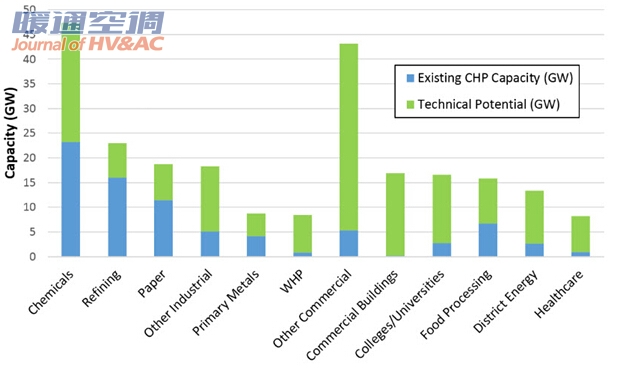热门
 Holmak: Heat exchanger made of PET
Holmak: Heat exchanger made of PET "China Water efficiency label management" implem…
"China Water efficiency label management" implem… Build Eco Xpo (BEX) Asia and Mostra Convegno Exp…
Build Eco Xpo (BEX) Asia and Mostra Convegno Exp… MOSTRA CONVEGNO EXPOCOMFORT (MCE) ASIA TO DEBUT…
MOSTRA CONVEGNO EXPOCOMFORT (MCE) ASIA TO DEBUT… CRAA published nameplate code of multi split air…
CRAA published nameplate code of multi split air… 2019 China AC market marked by slide domestic sa…
2019 China AC market marked by slide domestic sa… Global air conditioning systems market is expect…
Global air conditioning systems market is expect…
DOE: The combined heat and power (CHP) technical potential in the U.S.
The U.S. Department of Energy has published its annual report on the potential of CHP systems in the U.S. The study estimates that there is more than 240 GW of technical CHP potential at over 291,000 sites within the U.S.
From the Executive Summary:
Combined heat and power (CHP) is an efficient and clean approach to generating electric power and useful thermal energy from a single fuel source. Instead of purchasing electricity from the distribution grid and separately burning fuel in an on – site furnace or boiler to produce thermal energy, an industrial or commercial facility can use combined heat and power to provide both services in one, energy – efficient step CHP is a clean energy solution that directly addresses a number of national priorities, including improving U.S. competitiveness by:
§ reducing energy operating costs,
§ increasing energy efficiency,
§ reducing greenhouse gas emissions,
§ enhancing our energy infrastructure,
§ improving energy security and resiliency, and
§ “ growing ” the U.S economy.
There are several emerging market drivers contributing to current CHP growth, including lower energy operating costs, CHP – friendly environmental regulations, resiliency initiatives, federal and state policies and incentives, utility support, and project replicability. The drivers that are currently influencing the market growth of CHP are part of a larger recognition of the benefits that CHP provides both to the user and the nation as a whole. CHP can reduce strain on the electric grid and lower greenhouse gas (GHG) and other harmful emissions. CHP can lessen the need for new transmission and distribution infrastructure and uses abundant clean domestic energy sources such as natural gas and biomass.

Table 1: Total U.S. CHP Technical Potential Across All Facility Types (U.S. DOE)
CHP can be utilized in a variety of industrial facilities and commercial buildings with coincident power and thermal loads. Industrial manufacturing facilities that are a good fit for CHP include food processing, chemicals, refining and metal manufacturing For commercial buildings, year – round coincident on – site loads suitable for CHP are present at hospitals, multifamily buildings, colleges and universities, waste water treatment plants and military campuses. In this report, waste water treatment plants refer to facilities that treat water, wastewater and sewage/sanitary waste. In addition to industrial and commercial facilities, CHP can also be integrated in to district energy systems.
This study considers both traditional “topping cycle” CHP and “bottoming cycle” or waste heat to power CHP (WHP CHP). Topping cycle CHP systems are the most common CHP systems currently in use. In a topping cycle system, fuel is first combusted to generate electricity. A portion of the heat left over from the electricity generation process is then converted into useful thermal energy (e.g. heating, hot water, or steam for industrial processes). A bottoming – cycle CHP system, which will be referred to as WHP CHP in this report, uses the reverse process. Fuel is first combusted to provide thermal input to industrial process equipment like a kiln or furnace, and the heat rejected from the process is then captured and used for power production.
The study discusses the typical industrial facilities and commercial buildings that support “topping cycle” CHP, “bottoming cycle” or waste heat to power CHP (WHP CHP), and district energy CHP. The goal of the report is to provide data on the technical potential for CHP in sufficient detail for stakeholders to consider combined heat and power in strategic energy planning and energy efficiency program design. Data are provided nationally by CHP system size range, facility type, and location. Each state’s technical potential is also delineated by these characteristics.
The technical potential is an estimation of market size constrained only by technological limits — the ability of CHP technologies to fit customer energy needs without regard to economic or market factors. Across all CHP categories, there is estimated to be more than 240 GW of technical potential at over 291,000 sites within the U.S. Table 1 represents the total CHP technical potential identified in the United States by application or business type, including on – site CHP at industrial and commercial facilities, export, waste heat to power applications or district energy systems that could integrate CHP.

Figure 1: Existing CHP compared to on-site technical potential by sector (U.S. DOE)
In contrast to the existing facilities with installed CHP, which are heavily concentrated at large industrial manufacturing facilities, a significant portion of the remaining technical potential for on – site CHP in the U.S. is located in commercial facilities. Figure 1 shows both existing CHP and estimated technical potential capacity for on – site CHP in the most predominant sectors.
More information: http://energy.gov/sites/prod/files/2016/03/f30/CHP%20Technical%20Potential%20Study%203-18-2016%20Final.pdf




